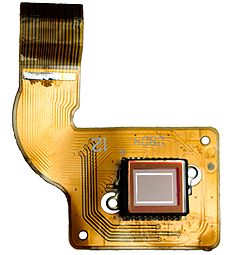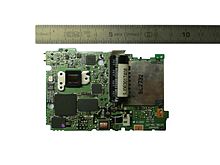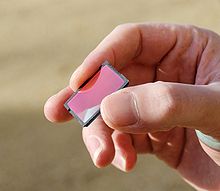- Image sensor
-
An image sensor is a device that converts an optical image into an electronic signal. It is used mostly in digital cameras and other imaging devices. Early analog sensors were video camera tubes, most currently used are digital charge-coupled device (CCD) or complementary metal–oxide–semiconductor (CMOS) active pixel sensors.
Contents
CCD vs CMOS
Today, most digital still cameras use either a CCD image sensor or a CMOS sensor. Both types of sensor accomplish the same task of capturing light and converting it into electrical signals.
A CCD image sensor is an analog device. When light strikes the chip it is held as a small electrical charge in each photo sensor. The charges are converted to voltage one pixel at a time as they are read from the chip. Additional circuitry in the camera converts the voltage into digital information.
A CMOS imaging chip is a type of active pixel sensor made using the CMOS semiconductor process. Extra circuitry next to each photo sensor converts the light energy to a voltage. Additional circuitry on the chip may be included to convert the voltage to digital data.
Neither technology has a clear advantage in image quality. On one hand, CCD sensors are more susceptible to vertical smear from bright light sources when the sensor is overloaded; high-end frame transfer CCDs in turn do not suffer from this problem. On the other hand, CMOS sensors are susceptible to undesired effects that come as a result of rolling shutter.
CMOS can potentially be implemented with fewer components, use less power, and/or provide faster readout than CCDs. CCD is a more mature technology and is in most respects the equal of CMOS.[1][2] CMOS sensors are less expensive to manufacture than CCD sensors.
Another hybrid CCD/CMOS architecture, sold under the name "sCMOS", consists of CMOS readout integrated circuits (ROICs) that are bump bonded to a CCD imaging substrate – a technology that was developed for infrared staring arrays and now adapted to silicon-based detector technology.[3] Another approach is to utilize the very fine dimensions available in modern CMOS technology to implement a CCD like structure entirely in CMOS technology. This can be achieved by separating individual poly-silicon gates by a very small gap. These hybrid sensors are still in the research phase, and can potentially harness the benefits of both the CCDs and the CMOS imagers.[4]
Performance
See also: EMVA1288There are many parameters that can be used to evaluate the performance of an image sensor, including its dynamic range, its signal-to-noise ratio, its low-light sensitivity, etc. For sensors of comparable types, the signal-to-noise ratio and dynamic range improve as the size increases.
Color separation
There are several main types of color image sensors, differing by the means of the color separation mechanism:
- Bayer sensor, low-cost and most common, using a color filter array that passes red, green, or blue light to selected pixel sensors, forming interlaced grids sensitive to red, green, and blue – the missing color samples are interpolated using a demosaicing algorithm. In order to avoid interpolated color information, techniques like color co-site sampling use a piezo mechanism to shift the color sensor in pixel steps. The Bayer sensors also include back-illuminated sensors, where the light enters the sensitive silicon from the opposite side of where the transistors and metal wires are, such that the metal connections on the devices side are not an obstacle for the light, and the efficiency is higher.[3][4]
- Foveon X3 sensor, using an array of layered pixel sensors, separating light via the inherent wavelength-dependent absorption property of silicon, such that every location senses all three color channels.
- 3CCD, using three discrete image sensors, with the color separation done by a dichroic prism. Considered the best quality, and generally more expensive than single-CCD sensors.
Sensors used in digital cameras
-
Width Height Aspect ratio Actual pixel count Megapixels Camera examples 320 240 
76,800 0.07 Steven Sasson Prototype (1975) 640 480 
307,200 0.3 Apple QuickTake 100 (1994) 832 608 
505,856 0.5 Canon Powershot 600 (1996) 1,024 768 
786,432 0.8 Olympus D-300L (1996) 1,280 960 
1,228,800 1.3 Fujifilm DS-300 (1997) 1,280 1,024 5:4 1,310,720 1.3 Fujifilm MX-700, Fujifilm MX-1700 (1999), Leica Digilux (1998), Leica Digilux Zoom (2000) 1,600 1,200 
1,920,000 2 Nikon Coolpix 950, Samsung GT-S3500 2,012 1,324 
2,663,888 2.74 Nikon D1 2,048 1,536 
3,145,728 3 Canon PowerShot A75, Nikon Coolpix 995 2,272 1,704 
3,871,488 4 Olympus Stylus 410, Contax i4R (although CCD is actually square 2,272x2,272) 2,464 1,648 
4,060,672 4.1 Canon 1D 2,560 1,920 
4,915,200 5 Olympus E-1, Sony Cyber-shot DSC-F707, Sony Cyber-shot DSC-F717 2,816 2,112 
5,947,392 5.9 Olympus Stylus 600 Digital 3,008 2,000 
6,016,000 6 Nikon D40, D50, D70, D70s, Pentax K100D 3,072 2,048 
6,291,456 6.3 Canon EOS 10D, Canon EOS 300D 3,072 2,304 
7,077,888 7 Olympus FE-210, Canon PowerShot A620 3,456 2,304 
7,962,624 8 Canon EOS 350D 3,264 2,448 
7,990,272 8 Olympus E-500, Olympus SP-350, Canon PowerShot A720 IS,Apple iPhone 4S 3,504 2,336 
8,185,344 8.2 Canon EOS 30D, Canon EOS-1D Mark II, Canon EOS-1D Mark II N 3,520 2,344 
8,250,880 8.25 Canon EOS 20D 3,648 2,736 
9,980,928 10 Olympus E-410, Olympus E-510, Panasonic FZ50, Fujifilm FinePix HS10 3,872 2,592 
10,036,224 10 Nikon D40x, Nikon D60, Nikon D3000, Nikon D200, Nikon D80, Pentax K10D, Pentax K200D, Sony Alpha A100 3,888 2,592 
10,077,696 10.1 Canon EOS 40D, Canon EOS 400D, Canon EOS 1000D 4,064 2,704 
10,989,056 11 Canon EOS-1Ds 4,000 3,000 
12,000,000 12 Canon Powershot G9, Fujifilm FinePix S200EXR, Nikon Coolpix L110 4,256 2,832 
12,052,992 12.1 Nikon D3, Nikon D3S, Nikon D700, Fujifilm FinePix S5 Pro 4,272 2,848 
12,166,656 12.2 Canon EOS 450D 4,032 3,024 
12,192,768 12.2 Olympus PEN E-P1 4,288 2,848 
12,212,224 12.2 Nikon D2Xs/D2X, Nikon D300, Nikon D300S, Nikon D90, Nikon D5000, Pentax K-x 4,900 2,580 
12,642,000 12.6 RED ONE Mysterium 4,368 2,912 
12,719,616 12.7 Canon EOS 5D 7,920 (2,640 × 3) 1,760 
13,939,200 13.9 Sigma SD14, Sigma DP1 (3 layers of pixels, 4.7 MP per layer, in Foveon X3 sensor) 4,672 3,104 
14,501,888 14.5 Pentax K20D, Pentax K-7 4,752 3,168 
15,054,336 15.1 Canon EOS 50D, Canon EOS 500D 4,928 3,262 
16,075,136 16.1 Nikon D7000, Pentax K-5 4,992 3,328 
16,613,376 16.6 Canon EOS-1Ds Mark II, Canon EOS-1D Mark IV 5,184 3,456 
17,915,904 17.9 Canon EOS 7D, Canon EOS 60D, Canon EOS 600D, Canon EOS 550D 5,270 3,516 
18,529,320 18.5 Leica M9 5,616 3,744 
21,026,304 21.0 Canon EOS-1Ds Mark III, Canon EOS-5D Mark II 6,048 4,032 
24,385,536 24.4 Sony α 850, Sony α 900, Nikon D3X 7,500 5,000 
37,500,000 37.5 Leica S2 7,212 5,142 
39,031,344 39.0 Hasselblad H3DII-39 7,216 5,412 
39,052,992 39.1 Leica RCD100 7,264 5,440 
39,516,160 39.5 Pentax 645D 7,320 5,484 
40,142,880 40.1 Phase One IQ140 8,176 6,132 
50,135,232 50.1 Hasselblad H3DII-50, Hasselblad H4D-50 11,250 5,000 9:4 56,250,000 56.3 Better Light 4000E-HS (scanned) 8,956 6,708 
60,076,848 60.1 Hasselblad H4D-60 8,984 6,732 
60,480,288 60.5 Phase One IQ160, Phase One P65+ 10,320 7,752 
80,000,640 80 Leaf Aptus-II 12, Leaf Aptus-II 12R 10,328 7,760 
80,145,280 80.1 Phase One IQ180 9,372 9,372 1:1 87,834,384 87.8 Leica RC30 12,600 10,500 6:5 132,300,000 132.3 Phase One PowerPhase FX/FX+ (scanned) 18,000 8,000 9:4 144,000,000 144 Better Light 6000-HS/6000E-HS (scanned) 21,250 7,500 17:6 159,375,000 159.4 Seitz 6x17 Digital (scanned) 16,352* 12,264* 
200,540,928 200.5 Hasselblad H4D-200MS(*actuated) 18,000 12,000 
216,000,000 216 Better Light Super 6K-HS (scanned) 24,000 15,990 2,400:1,599 383,760,000 383.8 Better Light Super 8K-HS (scanned) 30,600 13,600 9:4 416,160,000 416.2 Better Light Super 10K-HS (scanned) 62,830 7,500 6,283:750 471,225,000 471.2 Seitz Roundshot D3 (80 mm lens) (scanned) 62,830 13,500 6,283:1,350 848,205,000 848.2 Seitz Roundshot D3 (110 mm lens) (scanned) 38,000 38,000 1:1 1,444,000,000 1,444 Pan-STARRS PS1 157,000 18,000 157:18 2,826,000,000 2,826 Better Light 300 mm lens Digital (scanned)
Specialty sensors
Special sensors are used in various applications such as thermography, creation of multi-spectral images, video laryngoscopes, gamma cameras, sensor arrays for x-rays, and other highly sensitive arrays for astronomy.
Companies
The largest companies that manufacture imaging sensors include the following:
- Agilent
- Aptina
- Canesta
- Canon
- Cypress Semiconductor
- Eastman Kodak
- ESS Technology
- Fuji
- MagnaChip
- Matsushita
- Micron Technology
- Mitsubishi
- Nikon
- OmniVision Technologies
- PixArt Imaging
- Pixim
- Samsung
- Sharp
- Sony
- STMicroelectronics
- Toshiba
- TowerJazz
- TransChip
- Trusight
See also
- Video camera tube
- Semiconductor detector
- Full-frame digital SLR
- Image sensor format, the sizes and shapes of common image sensors
- Color filter array, mosaic of tiny color filters over color image sensors
- Sensitometry, the scientific study of light-sensitive materials
- History of television, the development of electronic imaging technology since the 1880s.
References
- ^ CCD vs CMOS from Photonics Spectra 2001
- ^ Sensors By Vincent Bockaert
- ^ a b [1]
- ^ a b CCD in CMOS Padmakumar R. Rao et al., "CCD structures implemented in standard 0.18 µm CMOS technology"
External links
Categories:- Digital photography
- Image sensors
Wikimedia Foundation. 2010.



